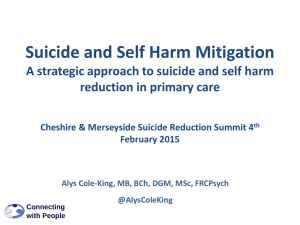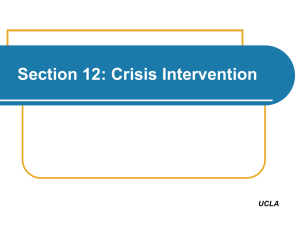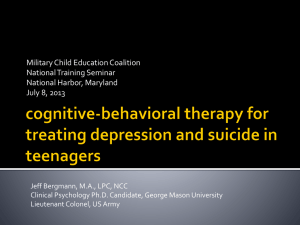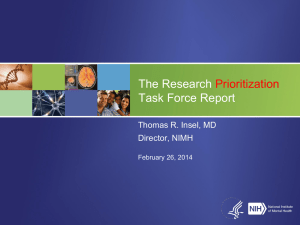Poland
advertisement
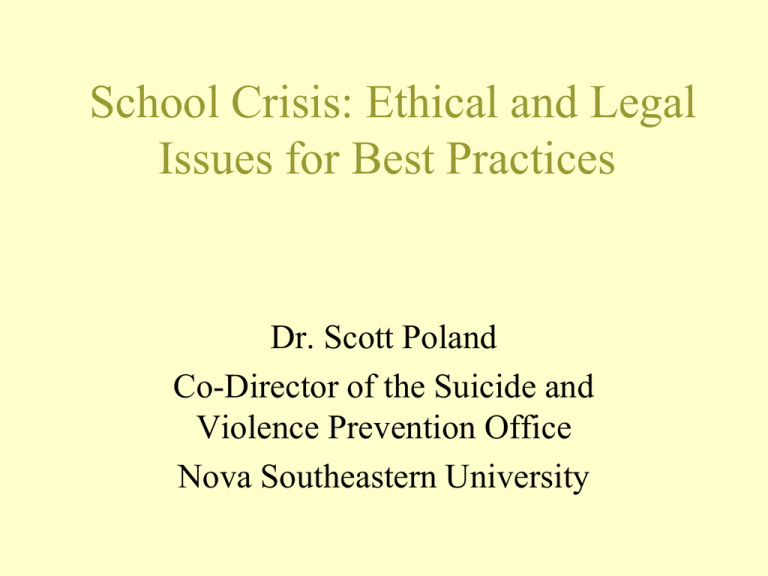
School Crisis: Ethical and Legal Issues for Best Practices Dr. Scott Poland Co-Director of the Suicide and Violence Prevention Office Nova Southeastern University NASP Principles for Professional Ethics: Revised 2010 • Respect dignity and rights of all persons • Honesty and integrity in professional relationships • Responsibility to schools, families, community, the profession and society • Professional competence and responsibility NASP Principles: Key Concepts • School psychologists consider children to be their primary responsibility and act as advocates for their welfare. • We also understand the public policy process to assist us in our efforts to advocate for children. • At the very least we do no harm. Legal Cases Review • There are many legal cases that have implications for crisis intervention and school psychologists • School psychology literature about legal and ethical issues in school crisis is lacking • The following cases highlighted in a lessons learned format are all cases that I was personally involved in Civil Lawsuits Against School Personnel: Common Questions • • • • Did an injury occur? Did the school owe a duty to the student? Was there a breach of duty? Is there a causal relationship between the injury and a breach of duty? Choquette vs. Onstedt Schools Elementary age students on school bus viewed a suicide victim • Parents were called immediately and a group activity provided next day for all bus riders (grades 1 to 6) by psychologist and counselor • One family did not want their 1st grade daughter to be told truth and later pulled her out of school and sued • The suit for 10$ million claimed she had PTSD as a result of intervention provided Activity • What do you think of the merits of the Choquette lawsuit? • How would you defend the school psychologist and counselor? • Was is it appropriate to conduct one intervention for bus riders grades 1 to 6? • Should parent permission have been obtained prior to the intervention for students? Landmark Cases • Wyke v Polk County School Board in Florida 11th Federal Circuit Court found the district liable for not offering a suicide prevention program, providing inadequate supervision of a suicidal student and failing to notify parents when their child was suicidal Landmark Cases • Szostek v Fowler and the CypressFairbanks School District 189th District Court found the school had not negligently disciplined the student who died by suicide and were entitled to sovereign immunity. This case does highlight school discipline has been a common precipitating event for suicide. Hope Witsell Tragedy • Middle school teen endured months of taunting after she sent a topless photo to a fellow student • The day before her suicide, she met with a social worker who had her sign a no suicide contract • No other school staff nor the parents were notified and parents found the contract after she hanged herself • Do you see a defense in the lawsuit and how do we prevent tragedies like this? Parent Notification Issue: Suicidal Student • Maryland school psychologist believed a student to be suicidal and notified parents. Student was allowed to walk home per parent request. Student died by suicide that night and the parents filed a lawsuit against the school and the psychologist. Parent Notification Case: White Pass, WA. • Sixteen year old male student • Referred to school counselor after he wrote a suicide note and gave it to a friend and there were rumors about a suicide pact • Student denied suicidal ideation or plans when interviewed by counselor • Please consider whether or not you would call parents after you review the following pieces of information that he shared with the counselor Shared with Counselor • New to school had been there 5 weeks • Sad as his best friend at new school who he was rumored to be in a pact with attempted suicide today • Under stress as facing felony charges • Gets along well with grandmother (who he now lives with) but not his mother as she hates him • His mother tried to kill herself last year • He reports his mother thinks he will probably kill himself • He reported he used to drink but has been sober for two weeks U.S. Eastern District Court Lance v Lewisville ISD • 9 year old boy M. hung himself in the school nurses bathroom in 2010 • Special education student with Speech, Learning Disabilities and ADHD • In 2008 his parents referred him for psychological evaluation due to their concerns that he was suicidal • ARD in 2008 identified him with Emotionally Disturbed • The district does not have the psych evaluation that qualified M with ED • They have BASC raw data only that documents suicide/depression • He received special education counseling but there is no documentation that service provider ever talked with him about suicidal ideation • From the start of the school year 2009-2010 and his death on 1/21/10 there were 30 behavioral incidents that resulted in him seeing the AP • The AP viewed each incident as conflict not bullying as that would have required the incidents to be written up and sent to the Superintendent • No evidence that the AP reviewed his IEP or his BIP • M saw the nurse on 16 occasions that year and on 7 of those occasions had physical injuries suffered at school • On 12/18/09 five students assaulted M in and he pulled a pocket knife from his pocket but did not open it • M was sent to the DAEP for 10 days and no MDR was held • His parents appealed the DAEP in writing first to the Principal and then to the Assistant Superintendent stating that he had been bullied • The appeals were denied • The DAEP was not notified that M was a special education student • M was suicidal at the DAEP and a high school counselor interviewed him and called his father but failed to fill out paperwork as per district protocol and did not notify his home elementary school of his suicidal ideation • M was in trouble on his second day back at his home campus and he hung himself in the nurse clinic bathroom • The nurse had known for two years that she did not have a key to unlock the bathroom door and M and other students had been known to lock themselves in the bathroom and she had to call custodian for help • No one ever told the nurse that M was known to be suicidal • The day after he died a new lock was installed and the nurse was provided a key to the bathroom Legal Term: Special Relationship • “In loco parentis doctrine” raises the question of whether a special relationship exists between school officials and students as students are released by parents for control and supervision by school officials • Critical issues are the age and existence of disabilities for a student and whether or not the district placed the student in harms way Lance Case: Outcome • Court dismissed the case and placed emphasis on the 2012 Doe v Covington case decided by the Fifth Circuit Court • No Special Relationship existed as he was not incarcerated, involuntarily committed, nor in foster care • He was not discriminated against as the AP failed to implement the bullying prevention policy for all students Bullying and Suicide • Children who have been bullied have reported a variety of behavioral, emotional and social problems. • Suicide is the third largest cause of mortality in children and adolescents. • Studies reported positive associations between all bullying types and suicidal risks. What does the research say? • Kaminsky (2009) victimization by peers is associated with greater reporting of suicidal ideation and behavior. • Klomek, Sourander & Gould (2010) found that bullies also have been reported to have an increased prevalence of suicidal ideation and suicide attempts. • Kim & Leventhal (2008) discussed that any participation in bullying increases the risk of suicidal ideation and behaviors, with the strongest risk for suicide was in Victim-Perpetrators. • Klomek, Sourander & Gould (2010) reported that the associations between bullying behaviors and suicidality have been found in children of all ages. • D’Augelli and colleagues (2005) found that increased sexual orientation-based verbal victimization, as well as psychological abuse from parents predicted suicide attempts described as ‘‘gay related.’’ • Traditional bullying and cyberbullying have been found to be related to suicidal ideation in similar ways (Klomek et al., 2008; Hinduja & Patchin, 2010). SPRC Brief: Suicide and Bullying • Both victims and perpetrators are at higher risk than peers • Personal characteristics such as internalizing problems; low self-esteem; and low assertiveness increase the risk of being bullied and these factors are also associated with risk for suicide • Children most at risk for suicide are also at risk for being bullied and it is difficult to control all the risk factors to determine if being bullied was a proximal cause to a youth suicide SPRC Continued • Personal risk factors alone do not cause a child to be suicidal as other key components are family, mistreatment, domestic violence, parental depression and a school environment that lacks adequate support and supervision along with inconsistent discipline • Relationship between bullying and suicide is the strongest for LGBTQ youth • Promotion of social support, mental health services and connectedness at school is recommended Bullying and Suicide Prevention: Common Strategies • Promote a positive school environment • Educate parents about warning signs and increase their involvement • Key is to build relationships with all students • Identify students and families in need of services and obtain services for them Suicide Postvention • Mares v Shawnee Mission Schools Kansas the school system settled out of court after being sued following the suicides of two brothers. The district failed to implement suicide postvention procedures after the first death. State of Montana v Justine Winter 20/20 Season 31 Episode #50 • Nighttime car accident resulted in two deaths • Justine survived but has extensive medical injuries including brain damage and has no memory of the accident • Justine was 16 years, one month at the time of the accident and had texted her boy friend about crashing her car 6 minutes before the accident • She was tried in adult court on two counts of deliberate homicide • How might you defend her and does this case fit the pattern of youth suicide? • What do you want to know about Justine? Joiner’s Model of Suicide Risk, 2006 Lawsuit over Self Injury Notification • • • • • Coulter Vs. Washington Township, N.J. Issues Student deposition/insight into factors Parent deposition Counselor deposition Snohomish, WA Case • 9th grade female student M (late April) told her friend K who was angry at her boyfriend that she would stab K’s boyfriend for her • Her friend reported threat to the school counselor • School emergency expelled her and told M and her mother that M would need to get psychiatric care before she would be readmitted School Records and Knowledge • M seen as quiet, good student but grades declined 2nd semester 9th grade year and no history of any discipline incidents • 8th grade counselor’s notes say M talked about cutting, sexting and wanting to be raped • 9th grade counselor heard M might be cutting in Dec. that year and met with her • Checked with her mom in Jan. and found out M was in private counseling Continued • School counselor on date of threat in April without a release called the private psychologist to share M had thoughts of suicide and killing family members • M was evaluated by a psychiatrist for homicidal and suicidal thoughts and hospitalized for 5 days in a partial program • Diagnosis was Major Depression and Generalized Anxiety, M was already on an anti-depressant that was working but was guarded in treatment, not homicidal or suicidal at discharge Continued • Psychiatrist stated in writing that M was safe to return to school and was continuing in out patient treatment (only records school received) • School held re-entry meeting on 5/5 with school staff, M and her mother and alternative school was mentioned but declined by M and mom • Focus was largely academic and how to support M and behaviors to watch for • No behavioral concerns reported before end of school except PE teacher noted cuts legs Continued Fall Next Year • Meeting 9/22 with counselor, teachers, M and her mom • Mom reported M still in therapy and using skills learned and had a future orientation • Teachers shared largely academic concerns but M had talked of drugs, made at least one student uncomfortable and patted one student too hard, had done a paper on a serial killer and one on managing stress Stabbing Incident • Oct. 25th M who still continued in twice a month counseling and medication, hid in the restroom listening to violent music, with knives she had taken from her step-father • She waited for RR to clear then stabbed the last two girls in the RR, one of which nearly died, M did not know either girl • Plaintiff’s sued the treatment clinic that provided outpatient treatment , the hospital and the school Plaintiff’s Criticism of School • M should have been placed in alternative school or not allowed to return, should have been evaluated for Special education, there was no wraparound program on return from hospital, school should have insisted on more information from the hospital and clinic • School threat assessment in April was inadequate, M should have been searched every morning or escorted everywhere including to the RR or M should have been seen by school counselor every morning, More Questions • What else do you want to know about the treatment that M received at the clinic and hospital? • Is the law suit warranted against the school, clinic and hospital? • When a psychiatrist does a safety assessment what does that really mean? • Did the psychiatrist miss psychotic features to M’s illness? • Can schools force records to be released to them? Case Discussion Questions • What do you think of the case against the school? Can schools force the release of records? • Are school personnel in a position to question a safety letter from a psychiatrist? • What constitutes a thorough threat assessment and how good are we at predicting violence? How often do female adolescents attempt homicide and what is the relationship between homicide and suicide? Structured Assessment of Violent Risk Youth (SAVRY) • Risk viewed as “dynamic” subject to change not just as “static” • Improvement noted in clinicians’ ability to distinguish violent individuals, now better than chance accuracy • Previous assessment has been unstructured purely “clinical” SAVRY • Systematic risk assessment with checklist of risk factors related to violence for 12 to 18 year olds • Systematic risk assessments perform better than unstructured ones • Dynamic risk factors especially significant for adolescents • SAVRY has 4 domains and 30 items all items rated low medium or high SAVRY Domains • Historical risk factors such as history of violence, early initiation of violence, past supervision failure, history of NSSI or suicide attempts, exposure to violence in home, childhood maltreatment, parental criminality, early caregiver disruption, and poor school achievement SAVRY Domains • Social/Contextual risk factors such as peer delinquency, peer rejection, stress and poor coping, poor parental management, lack of personal/social support and community disorganization SAVRY Domains • Individual/Clinical Risk factors such as negative attitudes, risk taking/impulsivity, substance abuse, anger problems, low empathy/remorse, ADHD, poor compliance and low interest/commitment to school SAVRY Domains • Protective factors such as pro-social involvement, strong social support, strong attachment bonds, positive attitude towards intervention and authority, strong commitment to school and resilient personality traits • Available from Psychological Assessment Resources www.parinc.com How Can School Personnel Protect Themselves from Liability? • • • • • Maintain Liability Insurance Seek supervision and consultation Keep good records Document training on crisis intervention Provide Best Practices responses How Can School Psychologists Make A Difference? • Advocate for prevention programs in schools and communities • Collaborate with school administrators and relevant agencies • Increase the circle of care when students are known to be at risk • Keep up with best practices in crisis intervention More Information • spoland@nova.edu • www.nova.edu/suicideprevention • New book, Suicide in schools by Erbacher, Singer and Poland, Routledge Dec. 2014



